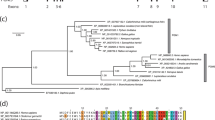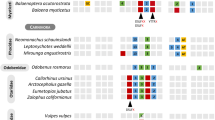Abstract
Phosphomannomutases (PMMs) catalyze the interconversion of mannose-6-phosphate to mannose-1-phosphate. In humans, two PMM enzymes exist—PMM1 and PMM2; yet, they have different functional specificities. PMM2 presents PMM activity, and its deficiency causes a Congenital Disorder of Glycosylation (PMM2-CDG). On the other hand, PMM1 can also act as glucose-1,6-bisphosphatase in the brain after stimulation with inosine monophosphate and thus far has not been implicated in any human disease. This study aims to refine the evolutionary time frame at which gene duplication gave rise to PMM1 and PMM2, and to identify the most likely amino acid positions underlying the proteins’ different functions. The phylogenetic analysis using available protein sequences, allowed us to establish that duplication occurred early in vertebrate evolution. In order to understand the molecular basis underlying the functional divergence, conserved and most likely functional divergence-related sites were identified, through the analysis of site-specific evolutionary rates. This analysis indicates that most of the sites known to be important in the homodimer formation and in the catalytic activity are conserved in both proteins. Among those potentially related to functional divergence, two positions (183 and 186 in human PMM1) emerge as the most interesting ones. The residues at these positions have different side-chain conformations in the protein structure in the unbound and bound states, and are highly but differently conserved in PMM1 and in PMM2 proteins. Altogether, these results provide new data into the evolutionary history of PMM1 and PMM2 duplicates and highlight the most probable sites that evolved to distinct functional specificities.



Similar content being viewed by others
References
Abascal F, Zardoya R, Posada D (2005) ProtTest: selection of best-fit models of protein evolution. Bioinformatics 21:2104–2105
Abhiman S, Sonnhammer EL (2005) Large-scale prediction of function shift in protein families with a focus on enzymatic function. Proteins 60:758–768
Altschul SF, Madden TL, Schaffer AA, Zhang J, Zhang Z, Miller W, Lipman DJ (1997) Gapped BLAST and PSI-BLAST: a new generation of protein database search programs. Nucleic Acids Res 25:3389–3402
Aravind L, Galperin MY, Koonin EV (1998) The catalytic domain of the P-type ATPase has the haloacid dehalogenase fold. Trends Biochem Sci 23:127–129
Beitner R, Haberman S, Livni L (1975) Complementarity in the regulation of phosphoglucomutase, phosphofructokinase and hexokinase; the role of glucose 1, 6-bisphosphate. Biochim Biophys Acta 397:355–369
Blouin C, Butt D, Roger AJ (2005) Impact of taxon sampling on the estimation of rates of evolution at sites. Mol Biol Evol 22:784–791
Bridgham JT, Carroll SM, Thornton JW (2006) Evolution of hormone-receptor complexity by molecular exploitation. Science 312:97–101
Burroughs AM, Allen KN, Dunaway-Mariano D, Aravind L (2006) Evolutionary genomics of the HAD superfamily: understanding the structural adaptations and catalytic diversity in a superfamily of phosphoesterases and allied enzymes. J Mol Biol 361:1003–1034
Cromphout K, Vleugels W, Heykants L, Schollen E, Keldermans L, Sciot R, D’Hooge R, De Deyn PP, von Figura K, Hartmann D, Korner C, Matthijs G (2006) The normal phenotype of Pmm1-deficient mice suggests that Pmm1 is not essential for normal mouse development. Mol Cell Biol 26:5621–5635
DeLano WL (2002) The PyMOL molecular graphics system. DeLano Scientific, Palo Alto, CA
Edgar RC (2004) MUSCLE: multiple sequence alignment with high accuracy and high throughput. Nucleic Acids Res 32:1792–1797
Freeze HH (2006) Genetic defects in the human glycome. Nat Rev Genet 7:537–551
Freeze HH (2009) Towards a therapy for phosphomannomutase 2 deficiency, the defect in CDG-Ia patients. Biochim Biophys Acta 1792:835–840
Gaucher EA, Miyamoto MM, Benner SA (2001) Function-structure analysis of proteins using covarion-based evolutionary approaches: elongation factors. Proc Natl Acad Sci USA 98:548–552
Gaucher EA, Das UK, Miyamoto MM, Benner SA (2002) The crystal structure of eEF1A refines the functional predictions of an evolutionary analysis of rate changes among elongation factors. Mol Biol Evol 19:569–573
Gerber G, Preissler H, Heinrich R, Rapoport SM (1974) Hexokinase of human erythrocytes. Eur J Biochem 45:39–52
Giles RH, Dauwerse HG, van Ommen GJ, Breuning MH (1998) Do human chromosomal bands 16p13 and 22q11-13 share ancestral origins? Am J Hum Genet 63:1240–1242
Godard CA, Goldstone JV, Said MR, Dickerson RL, Woodin BR, Stegeman JJ (2005) The new vertebrate CYP1C family: cloning of new subfamily members and phylogenetic analysis. Biochem Biophys Res Commun 331:1016–1024
Gribaldo S, Casane D, Lopez P, Philippe H (2003) Functional divergence prediction from evolutionary analysis: a case study of vertebrate hemoglobin. Mol Biol Evol 20:1754–1759
Gu X (1999) Statistical methods for testing functional divergence after gene duplication. Mol Biol Evol 16:1664–1674
Gu X (2001) Maximum-likelihood approach for gene family evolution under functional divergence. Mol Biol Evol 18:453–464
Guha SK, Rose ZB (1982) Brain glucose bisphosphatase requires inosine monophosphate. J Biol Chem 257:6634–6637
Guha SK, Rose ZB (1983) Role of inosine 5′-phosphate in activating glucose-bisphosphatase. Biochemistry 22:1356–1361
Guindon S, Gascuel O (2003) A simple, fast, and accurate algorithm to estimate large phylogenies by maximum likelihood. Syst Biol 52:696–704
Guindon S, Lethiec F, Duroux P, Gascuel O (2005) PHYML Online—a web server for fast maximum likelihood-based phylogenetic inference. Nucleic Acids Res 33:W557–W559
Guo AY, Zhu QH, Chen X, Luo JC (2007) GSDS: a gene structure display server. Yi Chuan 29:1023–1026
Hall TA (1999) BioEdit: a user-friendly biological sequence alignment editor and analysis program for Windows 95/98/NT. Nucleic Acid Symp Ser 41:95–98
Hansen SH, Frank SR, Casanova JE (1997) Cloning and characterization of human phosphomannomutase, a mammalian homologue of yeast SEC53. Glycobiology 7:829–834
Heykants L, Schollen E, Grunewald S, Matthijs G (2001) Identification and localization of two mouse phosphomannomutase genes, Pmm1 and Pmm2. Gene 270:53–59
Huelsenbeck JP, Ronquist F (2001) MRBAYES: Bayesian inference of phylogenetic trees. Bioinformatics 17:754–755
Hyndman K, Miyamoto M, Evans D (2009) Phylogeny, taxonomy, and evolution of the endothelin receptor gene family. Mol Phylogenet Evol 52:677–687
Jaeken J, Hennet T, Matthijs G, Freeze HH (2009) CDG nomenclature: time for a change!. Biochim Biophys Acta 1792:825–826
Jukes TH, Cantor CR (1969) Evolution of protein molecules. In: Munro HN (ed) Mammalian protein metabolism. Academic Press, New York
Knudsen B, Farid NR (2004) Evolutionary divergence of thyrotropin receptor structure. Mol Genet Metab 81:322–334
Knudsen B, Miyamoto MM (2001) A likelihood ratio test for evolutionary rate shifts and functional divergence among proteins. Proc Natl Acad Sci USA 98:14512–14517
Knudsen B, Miyamoto MM, Laipis PJ, Silverman DN (2003) Using evolutionary rates to investigate protein functional divergence and conservation. A case study of the carbonic anhydrases. Genetics 164:1261–1269
Koster JF, Slee RG, Staal GE, van Berkel TJ (1972) The influence of glucose 1, 6-diphosphate on the enzymatic activity of pyruvate kinase. Biochim Biophys Acta 258:763–768
Le Bizec C, Vuillaumier-Barrot S, Barnier A, Dupre T, Durand G, Seta N (2005) A new insight into PMM2 mutations in the French population. Hum Mutat 25:504–505
Leloir LF, Trucco RE et al (1948) The co-enzyme of phosphoglucomutase. Arch Biochem 19:339–340
Li P, Bousquet J (1992) Relative-rate test for nucleotide substitutions between two lineages. Mol Biol Evol 9:1185–1189
Lu Z, Dunaway-Mariano D, Allen KN (2005) HAD superfamily phosphotransferase substrate diversification: structure and function analysis of HAD subclass IIB sugar phosphatase BT4131. Biochemistry 44:8684–8696
Matthijs G, Schollen E, Pardon E, Veiga-Da-Cunha M, Jaeken J, Cassiman JJ, Van Schaftingen E (1997a) Mutations in PMM2, a phosphomannomutase gene on chromosome 16p13, in carbohydrate-deficient glycoprotein type I syndrome (Jaeken syndrome). Nat Genet 16:88–92
Matthijs G, Schollen E, Pirard M, Budarf ML, Van Schaftingen E, Cassiman JJ (1997b) PMM (PMM1), the human homologue of SEC53 or yeast phosphomannomutase, is localized on chromosome 22q13. Genomics 40:41–47
Matthijs G, Schollen E, Van Schaftingen E, Cassiman JJ, Jaeken J (1998) Lack of homozygotes for the most frequent disease allele in carbohydrate-deficient glycoprotein syndrome type 1A. Am J Hum Genet 62:542–550
Passonneau JV, Lowry OH, Schulz DW, Brown JG (1969) Glucose 1, 6-diphosphate formation by phosphoglucomutase in mammalian tissues. J Biol Chem 244:902–909
Philippe H, Casane D, Gribaldo S, Lopez P, Meunier J (2003) Heterotachy and functional shift in protein evolution. IUBMB Life 55:257–265
Pirard M, Collet JF, Matthijs G, Van Schaftingen E (1997) Comparison of PMM1 with the phosphomannomutases expressed in rat liver and in human cells. FEBS Lett 411:251–254
Pirard M, Achouri Y, Collet JF, Schollen E, Matthijs G, Van Schaftingen E (1999a) Kinetic properties and tissular distribution of mammalian phosphomannomutase isozymes. Biochem J 339:201–207
Pirard M, Matthijs G, Heykants L, Schollen E, Grunewald S, Jaeken J, van Schaftingen E (1999b) Effect of mutations found in carbohydrate-deficient glycoprotein syndrome type IA on the activity of phosphomannomutase 2. FEBS Lett 452:319–322
Quelhas D, Quental R, Vilarinho L, Amorim A, Azevedo L (2007) Congenital disorder of glycosylation type Ia: searching for the origin of common mutations in PMM2. Ann Hum Genet 71:348–353
Rijksen G, Staal GE (1977) Regulation of human erythrocyte hexokinase by glucose-1, 6-diphosphate and inorganic phosphate. FEBS Lett 80:61–65
Robinson M, Gouy M, Gautier C, Mouchiroud D (1998) Sensitivity of the relative-rate test to taxonomic sampling. Mol Biol Evol 15:1091–1098
Robinson-Rechavi M, Huchon D (2000) RRTree: relative-rate tests between groups of sequences on a phylogenetic tree. Bioinformatics 16:296–297
Ronquist F, Huelsenbeck JP (2003) MrBayes 3: Bayesian phylogenetic inference under mixed models. Bioinformatics 19:1572–1574
Rose IA, Warms JVB (1974) Glucose- and mannose-1, 6-P2 as activators of phosphofructokinase in red blood cells. Biochem Biophys Res Commun 59:1333–1340
Sarich VM, Wilson AC (1973) Generation time and genomic evolution in primates. Science 179:1144–1147
Schollen E, Pardon E, Heykants L, Renard J, Doggett NA, Callen DF, Cassiman JJ, Matthijs G (1998) Comparative analysis of the phosphomannomutase genes PMM1, PMM2 and PMM2psi: the sequence variation in the processed pseudogene is a reflection of the mutations found in the functional gene. Hum Mol Genet 7:157–164
Schollen E, Kjaergaard S, Legius E, Schwartz M, Matthijs G (2000) Lack of Hardy–Weinberg equilibrium for the most prevalent PMM2 mutation in CDG-Ia (congenital disorders of glycosylation type Ia). Eur J Hum Genet 8:367–371
Silvaggi NR, Zhang C, Lu Z, Dai J, Dunaway-Mariano D, Allen KN (2006) The X-ray crystal structures of human alpha-phosphomannomutase 1 reveal the structural basis of congenital disorder of glycosylation type 1a. J Biol Chem 281:14918–14926
Takezaki N, Rzhetsky A, Nei M (1995) Phylogenetic test of the molecular clock and linearized trees. Mol Biol Evol 12:823–833
Tarraga J, Medina I, Arbiza L, Huerta-Cepas J, Gabaldon T, Dopazo J, Dopazo H (2007) Phylemon: a suite of web tools for molecular evolution, phylogenetics and phylogenomics. Nucleic Acids Res 35:W38–W42
Thiel C, Lubke T, Matthijs G, von Figura K, Korner C (2006) Targeted disruption of the mouse phosphomannomutase 2 gene causes early embryonic lethality. Mol Cell Biol 26:5615–5620
Van Schaftingen E, Jaeken J (1995) Phosphomannomutase deficiency is a cause of carbohydrate-deficient glycoprotein syndrome type I. FEBS Lett 377:318–320
Veiga-da-Cunha M, Vleugels W, Maliekal P, Matthijs G, Van Schaftingen E (2008) Mammalian phosphomannomutase PMM1 is the brain IMP-sensitive glucose-1, 6-bisphosphatase. J Biol Chem 283:33988–33993
Wada Y, Sakamoto M (1997) Isolation of the human phosphomannomutase gene (PMM1) and assignment to chromosome 22q13. Genomics 39:416–417
Weber G, Jackson RC, Williams JC, Goulding FJ, Eberts TJ (1977) Enzymatic markers of neoplastic transformation and regulation of purine and pyrimidine metabolism. Adv Enzyme Regul 15:53–72
Wu CI, Li WH (1985) Evidence for higher rates of nucleotide substitution in rodents than in man. Proc Natl Acad Sci USA 82:1741–1745
Acknowledgments
This study was partially supported by the Portuguese Foundation for Science and Technology (FCT) through a PhD grant to R.Q. (SFRH/BD/23657/2005), a Ciência 2007 position to L.A. (C2007-IPATIMUP/AA1) and partially by the research project FCOMP-01-0124-FEDER-007167. IPATIMUP is an Associate Laboratory of the Portuguese Ministry of Science, Technology, and Higher Education and is partially supported by FCT.
Author information
Authors and Affiliations
Corresponding author
Electronic supplementary material
Below is the link to the electronic supplementary material.
Rights and permissions
About this article
Cite this article
Quental, R., Moleirinho, A., Azevedo, L. et al. Evolutionary History and Functional Diversification of Phosphomannomutase Genes. J Mol Evol 71, 119–127 (2010). https://doi.org/10.1007/s00239-010-9368-5
Received:
Accepted:
Published:
Issue Date:
DOI: https://doi.org/10.1007/s00239-010-9368-5




